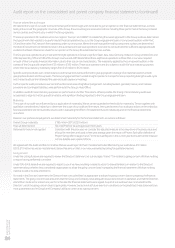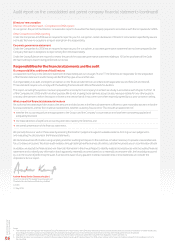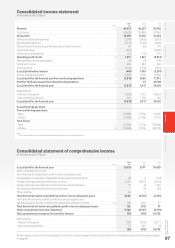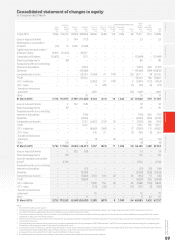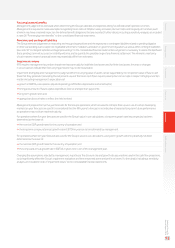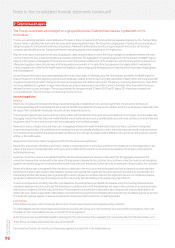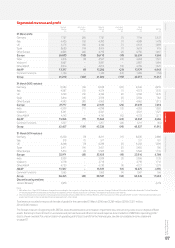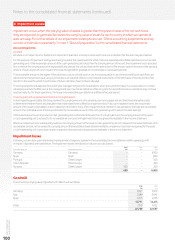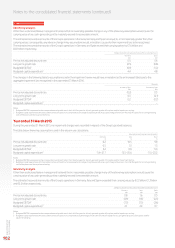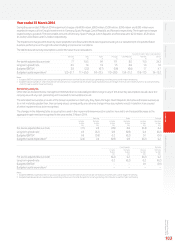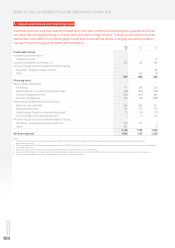Vodafone 2016 Annual Report Download - page 96
Download and view the complete annual report
Please find page 96 of the 2016 Vodafone annual report below. You can navigate through the pages in the report by either clicking on the pages listed below, or by using the keyword search tool below to find specific information within the annual report.
Vodafone Group Plc
Annual Report 2016
94
Notes to the consolidated nancial statements (continued)
1. Basis of preparation (continued)
Signicant accounting policies applied in the current reporting
period that relate to the nancial statements as a whole
Accounting convention
The consolidated nancial statements are prepared on a historical cost basis except for certain nancial and equity instruments that have been
measured at fair value.
Basis of consolidation
The consolidated nancial statements incorporate the nancial statements of the Company, subsidiaries controlled by the Company (see note 33
“Related undertakings” to the consolidated nancial statements) and joint operations that are subject to joint control (see note 12 “Investments
in associates and joint arrangements” to the consolidated nancial statements).
Foreign currencies
The consolidated nancial statements are presented in sterling, which was the parent company’s functional currency. Each entity in the Group
determines its own functional currency and items included in the nancial statements of each entity are measured using that functional currency.
With effect from 1 April 2016 the functional currency of the Company changed from sterling to the euro. The euro is now the primary currency
in which the Company’s nancing activities and investment returns are denominated.
The consolidated nancial statements are presented in sterling. With effect from 1 April 2016, the Group’s presentation currency will change from
sterling to the euro to better align with the geographic split of the Group’s operations.
The change of presentation and functional currency will not change either the Group’s or Company’s foreign exchange management strategy.
Transactions in foreign currencies are initially recorded at the functional currency rate prevailing at the date of the transaction. Monetary assets
and liabilities denominated in foreign currencies are retranslated into the respective functional currency of the entity at the rates prevailing on the
reporting period date. Non-monetary items carried at fair value that are denominated in foreign currencies are retranslated at the rates prevailing
on the initial transaction dates. Non-monetary items measured in terms of historical cost in a foreign currency are not retranslated.
Changes in the fair value of monetary securities denominated in foreign currency classied as available-for-sale are analysed between translation
differences and other changes in the carrying amount of the security. Translation differences are recognised in the income statement and other
changes in carrying amount are recognised inequity.
Translation differences on non-monetary nancial assets, such as investments in equity securities classied as available-for-sale, are reported as part
of the fair value gain or loss and are included in equity.
For the purpose of presenting consolidated nancial statements, the assets and liabilities of entities with a functional currency other than sterling
are expressed in sterling using exchange rates prevailing at the reporting period date. Income and expense items and cash ows are translated
at the average exchange rates for the period and exchange differences arising are recognised directly in equity. On disposal of a foreign entity,
the cumulative amount previously recognised in equity relating to that particular foreign operation is recognised in prot or loss.
Goodwill and fair value adjustments arising on the acquisition of a foreign operation are treated as assets and liabilities of the foreign operation and
translated accordingly.
In respect of all foreign operations, any exchange differences that have arisen before 1 April 2004, the date of transition to IFRS, are deemed to be nil
and will be excluded from the determination of any subsequent prot or loss on disposal.
The net foreign exchange loss recognised in the consolidated income statement for the year ended 31 March 2016 is £802 million (31 March
2015: £273 million gain; 2014: £1,688 million loss). The net gains and net losses are recorded within operating prot (2016: £2 million credit;
2015: £8 million charge; 2014: £16 million charge), other income and expense and non-operating income and expense (2016: £70 million
charge; 2015: £1 million credit; 2014: £1,493 million charge), investment and nancing income (2016: £726 million charge; 2015: £276 million
credit; 2014: £180 million charge) and income tax expense (2016: £8 million charge; 2015: £4 million credit; 2014: £1 million credit). The foreign
exchange gains and losses included within other income and expense and non-operating income and expense arise on the disposal of interests
in joint ventures, associates and investments from the recycling of foreign exchange gains previously recorded in the consolidated statement
of comprehensive income.
New accounting pronouncements adopted on 1 April 2015
On 1 April 2015 the Group adopted the following new accounting policies to comply with amendments to IFRS. The accounting pronouncements,
none of which is considered by the Group as signicant on adoption, are:
a Amendments to IAS 19 “Dened Benet Plans: Employee Contributions”;
a “Improvements to IFRS 2010–2012 cycle” amendment to IFRS 8 “Operating Segments”; and
a “Improvements to IFRS 2011–2013 cycle”.


